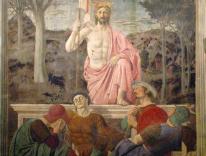
I read Shūsaku Endō’s Silence a few months ago, and at the end of chapter four, made a long annotation that opened, “In this letter, we are beginning to see that grace lies in the silence.”
There was never silence or stillness at Mass for me growing up. I was, and am, afflicted with attention deficit disorder. For a long time, my family worshipped in the gym of the local Catholic school, crammed into folding chairs, kneeling, standing, and watching Father Joe turn purple during a homily on compassion. For me, Mass was a test of endurance. I could never find the peace the nuns told us about in CCD. Although I'd learned what each part of the Mass meant, I couldn't linger on what was happening in front of me. I raced ahead in the missalette, willing the priest to speak as fast as I read. My restlessness never left enough room for grace to find its way in.
When I was eleven, a new church opened and we moved out of the gym. I remember two things. One was that Jesus was nailed to the cross through the wrists, which one of the priests explained was historically accurate because the hands wouldn't support His weight and nails would rip through them. The other was the old lady I sat next to one day, frail as her black lace mantilla. She had an honest-to-God missal, which I'd heard of but had never seen. It was in Latin. I immediately thought her the most Catholic woman on earth.
Later, as an adult, I attended Mass in fits and spurts, always seeking the shortest service. My wife and I managed to stay involved just enough for our sons to be baptized and receive communion, but I was just checking the boxes. So I tried living and experiencing my faith in other ways. I mimicked the church's outreach. I went into journalism because I thought I could help people. I read Flannery O’Connor. And I recalled how much I loved my religion classes in high school, where my teachers stressed morality over theology and questioning over conformity.
Then, three or four years ago, on a whim, I attended Latin Mass at St. Mary’s Cathedral in Austin, Texas. Just a block from the State Capitol, St. Mary’s is modest, with bare wood pews and a sanctuary set back from the congregation. I paged through a blue book that had Latin text on one page and English text on the facing page, with stage directions and illustrations in the margins.
Despite Catholic school and all that CCD, I didn’t realize until then the Novus ordo wasn’t just a straight translation. The Latin readings confused me; I couldn't tell, for example, just when the transubstantiation was occurring. But I knew without looking at the translation when we were saying “Lamb of God” and the Lord’s Prayer. I watched these strange ways of doing familiar things. The priest faced away from us. We knelt to take communion on the tongue. All the altar servers were male. I bowed at the priest during the recessional, incense still in my nostrils. Then I did something I'd never done after Mass. I sat in a pew, and I felt it: peace.
Since then, much in my life has tried to upset this peace. My career stalled. Hurricane Harvey destroyed my childhood home while my mother lay in the hospital recovering from a lung transplant, a recovery that would not come. But when I go to Mass at St. Mary's with my daughter, I leave with a sense of peace.
Worried that the mere existence of the Latin Mass will lead to a bi-ritualism that will split the Church, Massimo Faggioli recently wrote in Commonweal that “these disputes have wounded the sense of communion between Catholics.” He may have a point. No one at St. Mary's has been less than welcoming to me and to my family, but they do worry that I am going to hell for reading Commonweal. Called to a liturgy that hasn’t changed in centuries, they seem very close-knit, almost to the point of insularity. In the past, they’ve pushed the idea of establishing a parish of their own, separate from St. Mary's, where Mass would only be said in Latin. For many at St. Mary’s, the Latin Mass seems to be a part of a larger withdrawal from modern society, including Vatican II. Many homeschool their children, even for religious education. Some drive from as much as an hour away, making the weekly trek because they cannot find what they’re looking for in their home parishes. They seem to be a community within a community, creating walls, whether they mean to or not.
But the Latin Mass has a place for me. I don’t think it’s the future of the church, even though I’ve noticed the pews are filled with fellow Gen X-ers and their children. (My nine-year-old daughter has been to more Latin Masses than English.) The English Mass is too easy; the unfamiliarity of the Latin Mass requires me to quiet my mind, to focus, to attend to my faith in a way that Mass in English does not. It isn't a refuge from a changing world, but a base from which to engage it. My faith is not certain, and my doubt leads to questions. The Latin Mass welcomes me into the silence that allows me to seek the answers.
Please email comments to [email protected] and join the conversation on our Facebook page.
Previous Story
Masking One Wound with Another
Next Story
The Impeachment Question
